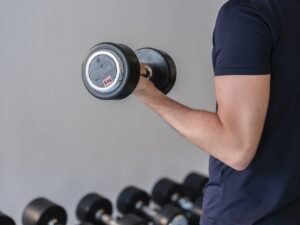Effective Home Resistance Training Routines
Are you tired of the monotony of your regular workout routine? Looking for a way to spice up your fitness regimen without leaving the comfort of your own home? Look no further than our article on Effective Home Resistance Training Routines. In this article, we will explore various exercises and techniques that will help you build strength and muscle using just your body weight and a few simple props. Say goodbye to expensive gym memberships and hello to a new and improved you, all from the convenience of your living room. It’s time to take your fitness journey to the next level!

This image is property of images.pexels.com.
Why Home Resistance Training?
Benefits of Home Resistance Training
Home resistance training offers a wide range of benefits that make it a convenient and effective option for people of all fitness levels. One of the primary advantages is the flexibility it provides in terms of scheduling your workouts. With a home resistance training routine, you no longer need to worry about gym hours or commuting to and from a fitness facility. You can exercise at any time that suits you, whether it’s early in the morning or late at night.
Another benefit of home resistance training is the cost-effectiveness it offers. Setting up a home gym requires an initial investment, but over time, it saves you money on gym memberships and transportation costs. You have the freedom to choose the equipment that fits your budget and preferences, without having to pay for a full range of machines and amenities offered at a commercial gym.
Furthermore, with home resistance training, you have complete privacy. This can be particularly appealing for those who may feel self-conscious about working out in public or being judged by others. You can focus on your exercises without any distractions, allowing for a more focused and productive workout.
Common Misconceptions about Home Resistance Training
Before diving into setting up your home resistance training space, it’s important to address some common misconceptions associated with this form of exercise. One misconception is that you need a large amount of space to have an effective home gym. While having a dedicated room or basement space can be advantageous, it is not necessary. With some creativity and planning, you can set up a home gym in a small corner of your living room or bedroom.
Another misconception is that home resistance training is limited in terms of exercise options. Many people mistakenly believe that they need expensive workout machines to achieve their fitness goals. However, there is a wide variety of resistance training exercises that can be done with minimal equipment or even just your own body weight. Additionally, you can get creative and use household items to create resistance, as we will explore later in this article.
Setting Up a Home Resistance Training Space
Identifying an Appropriate Space
When setting up a home resistance training space, it’s important to assess the available space in your home. It could be a spare room, a corner of your living room, or even your garage. Consider the amount of space you have and how it can be optimized for your workouts. Ensure that the space is well-lit, adequately ventilated, and free from any obstacles that may pose a safety risk.
Choosing the Right Equipment
Choosing the right equipment for your home gym will largely depend on your fitness goals, budget, and available space. Start with the basics, such as dumbbells, resistance bands, and a stability ball. These versatile and compact pieces of equipment can provide a full-body workout. As you progress, you may consider investing in a bench, barbells, or kettlebells to add variety and intensity to your workouts.
Creating a Safe Environment
Safety should be a top priority when setting up your home resistance training space. Ensure that the flooring is appropriate for exercises, such as using rubber mats for cushioning and traction. Clear the area of any potential hazards, such as loose wires or sharp objects. Additionally, consider installing mirrors to check your form during exercises and have a first aid kit readily available in case of any injuries.

This image is property of images.pexels.com.
Basic Resistance Training Principles
Understanding Muscular Adaptation
Muscular adaptation is a fundamental principle of resistance training. When you perform resistance exercises, your muscles are exposed to stress that causes microscopic damage to the muscle fibers. In response to this stress, your muscles adapt and become stronger. This adaptation occurs during the periods of rest and recovery, so it’s essential to allow adequate time for your muscles to repair and grow stronger.
Progressive Overload: The Key to Building Strength
Progressive overload is another important principle of resistance training that involves gradually increasing the demands placed on your muscles. It is the progressive increase in resistance, volume, or intensity of your workouts over time that prompts your muscles to continue adapting and getting stronger. Whether you increase the weight, repetitions, or sets, it’s essential to challenge your muscles consistently to achieve continual progress.
Warm-up and Cool-down Techniques
Before starting your resistance training session, it’s crucial to properly warm up your muscles to prepare them for the upcoming workout. This can be done through dynamic movements, such as arm swings, leg swings, and bodyweight exercises that mimic the movements you will perform during your workout. Cooling down after your workout with static stretches can help reduce muscle soreness and improve flexibility.
Resistance Training Exercises
Upper Body Exercises
Targeting your upper body is essential for developing strength and improving overall functional fitness. Some effective upper body resistance training exercises include push-ups, dumbbell or barbell bench presses, bent-over rows, shoulder presses, and bicep curls. These exercises engage muscles in your chest, back, shoulders, triceps, and biceps, providing a well-rounded upper body workout.
Lower Body Exercises
Strengthening your lower body is vital for stability, mobility, and overall lower body strength. Key lower body resistance training exercises include squats, lunges, deadlifts, calf raises, and hamstring curls. These exercises target muscles in your thighs, glutes, calves, and hamstrings, helping to build lower body strength and improve athletic performance.
Core Exercises
A strong core is essential for maintaining proper posture, stability, and preventing lower back pain. Core exercises can include planks, Russian twists, bicycle crunches, and mountain climbers. These exercises target your abdominal muscles, obliques, and lower back muscles, providing a stable base for all other movements and improving overall functional strength.
Full-Body Exercises
Incorporating full-body resistance training exercises into your routine ensures that you are engaging multiple muscle groups simultaneously, maximizing your workout efficiency and calorie burn. Examples of full-body exercises include burpees, squat presses, deadlift to overhead press, and kettlebell swings. These movements challenge your entire body, promoting overall strength and conditioning.

This image is property of images.pexels.com.
Designing Effective Resistance Training Programs
Defining Your Goals
Before designing a resistance training program, it’s vital to clearly define your fitness goals. Whether you aim to build muscle, lose weight, improve athletic performance, or enhance overall strength and endurance, your goals will shape the structure of your training program.
Determining Frequency, Intensity, and Duration
Frequency, intensity, and duration are key factors in designing an effective resistance training program. Frequency refers to how often you train a specific muscle group or perform a particular workout. Intensity refers to the level of difficulty or effort you put into each exercise. Duration refers to the length of each workout session. Finding the right balance of these variables is crucial to avoid overtraining or underwhelming your muscles.
Splitting Routines: Targeting Different Muscle Groups
To ensure comprehensive and balanced muscle development, it’s beneficial to split your training routine to target different muscle groups on different days. For example, you can dedicate one day to upper body exercises, another day to lower body exercises, and a separate day for core and full-body exercises. This approach allows for better recovery and prevents overuse injuries.
Incorporating Weightlifting Techniques
Proper Form and Technique
When incorporating weightlifting techniques into your home resistance training routine, it’s crucial to prioritize proper form and technique. Maintaining correct alignment, engaging the appropriate muscles, and avoiding jerky or excessive movements not only ensures maximum effectiveness but also reduces the risk of injury. If you are unsure about proper form, consider seeking guidance from a qualified personal trainer or using instructional videos.
Increasing Load Gradually
To continue challenging your muscles and promoting growth, you need to gradually increase the load you lift over time. This can be achieved by incrementally adding weight to your dumbbells or barbells or by progressing to heavier resistance bands. By gradually increasing the load, you allow your muscles to adapt and continue gaining strength without pushing them beyond their limits.
Avoiding Common Weightlifting Injuries
Weightlifting injuries can be prevented by following correct form and technique, gradually increasing the load, and listening to your body’s signals. It’s essential to start with lighter weights and focus on mastering proper form before progressing to heavier loads. Additionally, giving your muscles adequate rest and recovery time is crucial in preventing overuse injuries. If you experience persistent pain or discomfort, it’s advisable to seek medical attention to address any potential underlying issues.
Bodyweight Exercises for Home Resistance Training
Benefits of Bodyweight Exercises
Bodyweight exercises are an excellent option for home resistance training as they require minimal equipment and can be done practically anywhere. They offer numerous benefits, such as improved functional strength, enhanced body control and stability, and increased flexibility. Bodyweight exercises also promote better balance and coordination, making them suitable for individuals of all fitness levels.
Bodyweight Exercises for Different Muscle Groups
There is a wide variety of bodyweight exercises that target different muscle groups. For the upper body, exercises like push-ups, tricep dips, and plank variations engage the chest, arms, and core muscles. Lower body exercises, such as squats, lunges, and glute bridges, effectively work the quads, hamstrings, and glutes. Core exercises like planks, mountain climbers, and Russian twists engage the abdominal and back muscles.
Creative Ways to Modify Bodyweight Exercises
To increase the challenge and variety of your bodyweight exercises, there are several creative modifications you can incorporate. For example, elevating your feet during push-ups or lunges can engage different muscle fibers and intensify the exercise. Furthermore, you can incorporate plyometric variations like jump squats or clap push-ups to add an explosive element to your workout. Exploring these modifications can keep your workouts exciting and prevent plateaus in your progress.
Creating Resistance with Household Items
Using Water Bottles and Gallon Jugs
If you don’t have access to traditional resistance training equipment, don’t worry! You can create resistance with common household items. Water bottles and gallon jugs can be filled with water, sand, or even rocks to create makeshift dumbbells. Adjust the level of resistance by adding or removing the volume of the material inside the containers. This allows you to customize the weight according to your fitness level and exercise requirements.
Utilizing Backpacks and Bags
Backpacks and bags can be repurposed as weighted vests or sandbags to add resistance to your bodyweight exercises. Fill the backpack or bag with items like books, water bottles, or cans to increase its weight. Wear it during exercises like squats, lunges, or step-ups to intensify the workout and engage additional muscle groups.
Making Use of Furniture and Home Accessories
Don’t underestimate the potential of your furniture and other home accessories to act as resistance training tools. Couches, chairs, and beds can be used for exercises like tricep dips or elevated push-ups. Staircases can be utilized for step-ups or calf raises. Get creative and think outside the box to incorporate these items into your workouts, making your home resistance training even more versatile.
Effective Resistance Training Techniques for Beginners
Starting with Light Resistance
For beginners, it’s important to start with light resistance and focus on mastering proper form and technique. This allows your muscles, tendons, and ligaments to gradually adapt to the demands of resistance training, reducing the risk of injury. Begin with bodyweight exercises and gradually introduce lighter resistance bands or dumbbells as your strength and confidence increase.
Mastering Proper Form and Technique
Prioritizing proper form and technique should be the foundation of any resistance training routine, especially for beginners. By mastering the correct execution of each exercise, you ensure maximum muscle engagement and minimize the risk of injury. It can be helpful to seek guidance from fitness professionals, watch instructional videos, or join virtual classes to learn and perfect your form.
Monitoring Progress and Adjustments
As a beginner, it’s important to track your progress to ensure you are continually challenging yourself and making improvements. Keep a workout journal or use fitness tracking apps to record your exercises, sets, reps, and any modifications you make. Regularly reassess your fitness level, increase the resistance gradually, and make adjustments to your routine as needed.
Advanced Resistance Training Techniques
Supersets and Drop Sets
Supersets and drop sets are advanced resistance training techniques that can help maximize muscle engagement and intensity. Supersets involve performing two exercises back-to-back with little to no rest in between. This increases the overall workload and challenges your muscles further. Drop sets, on the other hand, involve gradually reducing the weight after reaching muscle fatigue, allowing you to push beyond your limits and stimulate further muscle growth.
Explosive Training
Explosive training involves performing exercises with maximum force and speed. This type of training recruits a greater number of muscle fibers and improves power output and athleticism. Techniques like jump squats, medicine ball throws, and plyometric push-ups are examples of explosive training exercises. However, it is important to progress gradually and ensure proper form to minimize the risk of injury.
Isometric Holds and Eccentric Movements
Isometric holds involve holding a static position, such as a plank or a wall sit, while engaging specific muscles. This type of training strengthens not only the targeted muscles but also improves stability and endurance. Eccentric movements, on the other hand, focus on the lengthening phase of a muscle contraction. Slowly lowering weights during bicep curls or squatting down in a controlled manner are examples of eccentric training. Incorporating isometric holds and eccentric movements can add variety to your routine and challenge your muscles in new ways.
In conclusion, home resistance training provides numerous benefits, including flexibility, cost-effectiveness, and privacy. By setting up an appropriate space, choosing the right equipment, and creating a safe environment, you can establish an effective home gym. Understanding the basic principles of resistance training, incorporating weightlifting techniques, and utilizing bodyweight exercises allow for comprehensive workouts targeting different muscle groups. By incorporating household items to create resistance, experimenting with effective training techniques, and making adjustments based on your fitness level, you can continuously challenge yourself and achieve your fitness goals through home resistance training.



